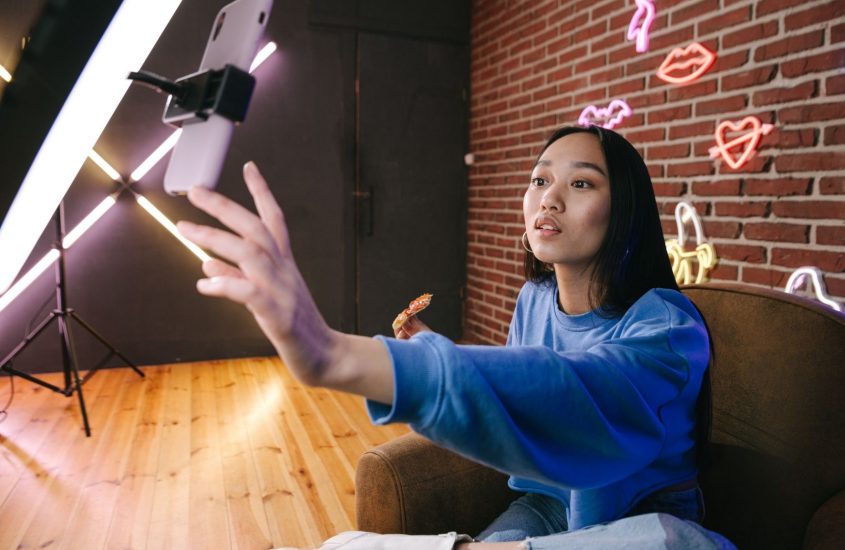I don’t understand influencers

I know I’m old because I don’t understand influencers and how they make a living. They’re not actual celebrities. Many don’t even have any obvious talents. Why are they a thing? How do you get that many followers in the first place?
I have so many questions, so I did a bit of research and this post is about what I found.
My image of influencers
I’ve seen so many videos and blog posts about influencers being super entitled. Many want free stuff or want to ‘pay’ with exposure. Honey, ‘exposure’ does not pay the bills.
When I think about influencers, I imagine those girls with big boobs and ass, but skinny waists who post edited photos of themselves on Instagram. They pose half-naked next to products and somehow that convinces people to buy stuff (?).
Obviously, the scene I painted above is not what all influencers are like.
Let’s dive into what I found.
What is it?
Basically, influencer marketing is marketing done on social media. People with many followers (called influencers) endorse products or place them in their videos with sponsored content. These are people with some kind of social influence over their audience and what they want to buy.1,2,3
Influencers are usually on social media like Instagram and TikTok, but they can also be on YouTube and bloggers. However, Instagram has been the leading platform for influencers. Also, a new trend is podcasters as influencers. Usually, influencers won’t just have one platform, but use multiple ones, sometimes to promote content on another platform.2
There are so many types of influencers from beauty, sport, food, minimalism etc. and all of those have niche audiences inside that type of content. Like vegan, or dance, or just hair, or just nails, etc.3
Celebrities were the OG influencers, and some still do endorsements today, but not as much as influencers. However, celebrities are much more expensive than your run-of-the-mill influencer and might not have the credibility of other influencers, as not everyone can relate to them.2
It kind of makes sense
The business side of it makes sense, although I hate to admit it. It’s all about your target audience.
Almost half the world’s population uses social media.2 For instance, Instagram alone has over one billion active users.3 Gen Z spends way more time watching online content, like YouTube, TikTok and other social media than traditional media, so that’s where you as an advertiser want to be.2
But then you have the problem of ad blockers or people (like me) who just straight-up ignore ads. (If I’m honest, if your ad is interrupting my video then I will avoid your product at all cost).1
So, for marketers, there has to be another way, something other than just your ‘traditional’ ads on the internet and social media, and that’s where influencers come in. Influencers can reach an audience of potential shoppers who have ad-blockers and don’t see traditional advertisements on social media.1
With traditional advertising, the company is seen as the expert on the product/industry and the customer can easily be manipulated into buying a product. However, these days consumers are seen as savvier and less manipulatable (well, debatable).4 So, many people are looking for a way to make a more informed choice about the products and services they use and hence turn to social media for advice.
What classifies as an influencer?
Influencers are separated by the number of followers they have on a social media platform. These could include traditional celebrities but also people who create content about a niche topic. These platforms are usually Instagram, YouTube, and TikTok. It’s not to say that if you have many followers that you are an influencer, but you actually need to have a relationship with your followers so that they will try to imitate you and use the products that you are endorsing.1,2
Mega-influencers are people with a vast number of followers. They usually have at least one million followers on a social media platform. They can be paid up to one million dollars for one sponsored post.2
Macro-influencers would have between 400k and one million followers on a social media platform. It would be easier for a business to find and afford a macro-influencer to work with.2
Then there are micro-influencers. They have between about 1000 and 40K followers on a social media platform.2
Relationship with their followers
Again, it’s not to say that if you have many followers, you are an influencer, but you actually need to have an influence on the purchasing choices of your following.1
Influencers build a relationship and trust with their audience and, over time, an influencer gains credibility with their audience and market. They create conversations about products and brands, and this drives sales. Influencers are seen as ‘informed consumers’.1
The best influencers have a niche audience and have built up their reputation as an expert in that niche over some time. Their reputation also links to the quality of their posts, social media posts, blog posts, videos, podcasts, etc. Their followers would rather believe their testimonies about products than some stranger or celebrity, and this might motivate people to buy those products. It’s kind of seen as the new ‘word-of-mouth’ in the modern sense.2
Influencers might also work because they’re just seen as normal people, but they have a certain look and lifestyle. Then people compare themselves to these influencers, even though they don’t have that lifestyle and become insecure about it. Then the influencers and brands use those insecurities against the follower, where they subliminally persuade the followers that if they buy and use the products, they will also look like that and have that lifestyle. It’s seen as a shortcut.1
The amount influencers get paid depends on their audience and reach, but also on the track record of the success of previous endorsements. It’s crazy how the most successful influencers and celebrity influencers can get paid between hundreds of thousands of dollars or even a million dollars for a single post on their social media.1
Problems with influencers
In the US, there are regulations in place that force influencers to disclose when they are doing endorsed/sponsored or paid ad posts. It has to be clear to the audience in unambiguous language.1 I’m not sure about the legislation around the world, but this is definitely something that should be in place worldwide.
Also, seeing as you need a lot of followers to be an influencer, there are many people who buy ‘followers’. Actually, some businesses sell these kinds of services of fake followers. These fake followers cost businesses money that use these influencers, and obviously, it’s fraudulent to lie knowingly about your social media following for money. Because of these potential fake followers, influencers and their actual influence can be called into question.1,4
Last, social media is not there to show the harsh realities of life. It’s the highlight reel of your life and showing your best angles. Influencers often come under fire for their unrealistic lifestyles and looks—a lifestyle that is not attainable for the average joe that follows them on social media.3
Lastly
I understand the logic behind influencers, but I’m still not a fan. What do you think of influencer marketing?
Meh.
Michelle
P.S. If you’d like to contact me, feel free to comment below, send an email to thatmichelleperson@gmail.com, or follow me on Twitter @M_ClutterBox.
P.P.S: I used these sources:
- https://en.wikipedia.org/wiki/Influencer_marketing
- https://influencermarketinghub.com/what-is-an-influencer/
- https://www.vice.com/en/article/vb55wa/instagram-influencers-history-2010s









